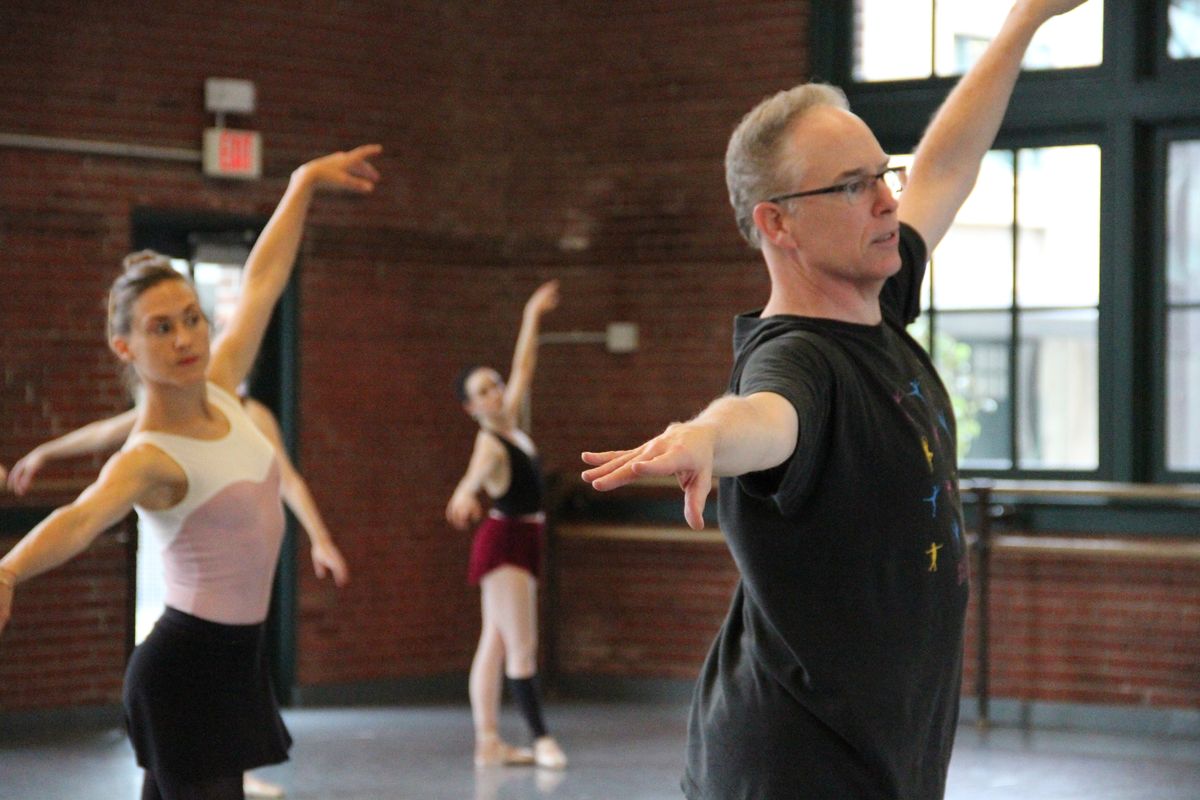At Devon Carney's Kansas City Ballet, the Roster of Dancers Keeps Growing
This story originally appeared in the April/May 2016 issue of
Pointe.
“There’s always boxes of color to help with that,” says Kansas City Ballet artistic director Devon Carney when I ask him if the long hours in the studio are turning his hair gray. It’s November, and he’s creating the company’s new $2 million Nutcracker production. “I love it,” he says. “There’s nothing like making something that will influence kids in their development as dancers.”
For Carney, there was a lot to love about the situation he stepped into in 2013 as only the fourth artistic director in Kansas City Ballet’s 59-year history. (Carney’s predecessor, William Whitener, retired after 17 years to work as an independent choreographer, teacher and arts advocate.) The company had recently moved into a brand-new, state-of-the-art facility, had a new performance home at the Kauffman Center for the Performing Arts and was free of debt. “It was pretty spectacular,” says Carney.
Now into year three of a plan to increase the number of dancers, raise the level of artistry and transform the company’s repertoire, Carney says the organization has already met most of those goals.
KCB, formerly known as the State Ballet of Missouri, was founded in 1957 by Tatiana Dokoudovska. Company dancer Logan Pachciarz says the AGMA-participating troupe has grown exponentially since he arrived in 2000. “It had about half the number of dancers then, and we did mostly ensemble works.”
Carney, a former principal dancer and ballet master at Boston Ballet, says his decade-long term as associate artistic director at Cincinnati Ballet helped prepare him for his first directorship. Growing the organization was one of his priorities when he arrived. First, he created the six-member second company, KCB II. In 2015, he instituted a nine-dancer trainee program. The additional dancers, says Carney, are not only necessary to do full-length ballets and outreach, but have also relieved the 28 company dancers of some of the corps work, freeing them up for more soloist and principal roles.
“In my career, I had a chance to experience a lot of different styles,” says Carney. “I think it’s important that the dancers here have that kind of opportunity to grow. I believe in them, and when someone believed in me, it really changed my confidence level.”
 Carney with the company after a run through of “The Nutcracker.” Photo by Jessica Kelly, Courtesy KCB.
Carney with the company after a run through of “The Nutcracker.” Photo by Jessica Kelly, Courtesy KCB.
With an annual operating budget of $8.5 million, Carney is cognizant of the ballets and choreographers he can bring in. Therefore, he needs performers who will excel in a variety of works. When hiring, Carney says, he looks for versatile dancers who will commit to the artistic intention of each piece. KCB now does a mix of full-length classics (something they did very little of before), neoclassical ballets like those of Balanchine, and contemporary works from a host of emerging and established choreographers, such as Edwaard Liang, Amy Seiwert, Jodie Gates and Val Caniparoli.
“He really challenges us to increase our technical level and ability,” says Pachciarz of Carney. “He’s a big fan of wide, sweeping movement and a lot of port de bras and épaulement.”
Ballet master and former Cincinnati Ballet principal Kristi Capps, who Carney hired in 2014, says he is “demanding, but in a caring way. For Devon, to see a dancer not put forth maximum effort is heartbreaking because he knows how short a dancer’s career is.”
Carney is also an accomplished choreographer, having created works for Boston Ballet, BalletMet, Cincinnati Ballet and Cincinnati Opera. Pachciarz says he “is very methodical. He reads scores and thinks about how the movement fits into them.” In addition to KCB’s new Nutcracker, Carney mounted the company’s first-ever full-length Swan Lake in February and restaged his Giselle for them in 2015.
 Carney with KCB dancer Joshua Bodden during company class. Photo by Jessica Kelly, Courtesy KCB.
Carney with KCB dancer Joshua Bodden during company class. Photo by Jessica Kelly, Courtesy KCB.
Artists who join KCB will step into a pretty spectacular situation, as Carney did. Their home, the new Todd Bolender Center for Dance & Creativity—a converted power plant—houses the company, administrative offices, Kansas City Ballet School and a 180-seat theater. Each production (apart from Nutcracker) runs two weekends at the Kauffman Center, with most performed to live music by the Kansas City Symphony. Dancers can benefit from extra performance opportunities in ongoing collaborations with organizations like the Lyric Opera of Kansas City, and they have the chance to choreograph as part of the company’s annual New Moves program.
Next up for KCB, May 6–15, is Adam Hougland’s Rite of Spring, along with works by Helen Pickett, Yuri Possokhov and a world premiere by Viktor Plotnikov. Beyond that, Carney’s plans for KCB include continued growth, in every direction. He aspires to add more dancers, have more collaborations and to tour—something they’ve done very little of. “I believe in this company,” says Carney. “There is so much left for us to do, and I am excited for what the future holds.”
Audition Advice
The company holds open auditions January to March. Videos are accepted year-round as a preliminary audition, but Carney highly recommends dancers attend an open audition.
“Musicality is paramount to me, as is attentiveness to the material and being able to exactly reproduce it quickly,” says Carney. Women generally need to be between 5′ 4″ and 5′ 7″. Male dancers should be 5′ 10″ and up, with strong partnering skills. Carney says he also places great importance on a dancer’s demeanor, professional appearance, resumé and photo.
Kansas City Ballet At a Glance
-
Number of dancers:
28 -
Length of contract:
35 weeks -
Starting salary:
$733 per week -
Performances per year:
48+ -
Website:
kcballet.org





